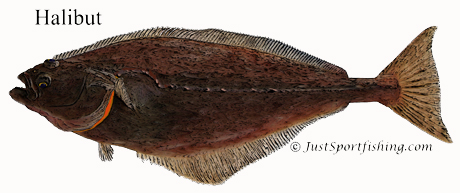|
|

How
to fish for Halibut
Halibut are opportunistic feeders. They will usually take whatever is edible that is presented to them. Halibut tend to lie on the bottom at the edge of tidal currents and rips waiting for the current to wash food into their general area. However the Halibut has an excellent sense of smell and will follow a chum slick. They are also strong swimmers and will occasionally swim to the surface to feed on herring and sand lance. Halibut feed on herring, squid, octopus, crab, cod, pollock, sablefish, and other fish or crustaceans that are plentiful in the Halibuts habitat.
Pacific Halibut range along the Pacific coast from California to Alaska. In fall and winter the Halibut moves offshore to very deep water and is out of range for most sport fishermen. In the spring and summer the Halibut once again moves into coastal regions and is found at depths of 50 to 750 feet.
The most successful way to fish for Halibut is jigging. The two methods that fishermen jig for Halibut is still and drifting. Still fishing is jigging at anchor, with fresh bait such as herring or octopus. Still jigging works very well when there are several boats in the same location. Halibut have excellent smell senses and will move substantial distances to come to a bait. When a group of still fishermen congregate in the same area with many rods of freshly hooked bait it almost creates its own chum slick attracting the Halibut into the area.
Drifting for Halibut is as the name implies, you position your boat up current of a known Halibut area and drift with the current over the area jigging the bottom as you drift. Once you have reached the end off the Halibut area you motor up current and drift over the area again.
Jigging consists of allowing your line to free spool until you hit bottom, raise your line a couple of cranks on the reel. Then slowly raise your rod tip 3 to 4 feet and quickly drop the tip back down, pause a few seconds and repeat. Continue this until a Halibut strikes your bait. If you feel a bite do not try to set your hook right away. Halibut are known for grabbing a bait and holding it for a few seconds before they inhale it. If you feel a hit count to 5 then set your hook.
Most Halibut rods are short, heavy action rods between 5-6 feet in length. A graphite, or composite rod, with roller guides is a good choice. These rods are thick and stiff for hauling up heavy fish, but not so good when it comes to feeling smaller bites. A large capacity saltwater reel spooled with at least 300 yds of braided line from 60 to 120 pound test.
A typical Halibut jigging rig consists of a 4/0 to 10/0 hook crimped or tied to 20 to 30 inches of mono or wire-strand leader. Tie on a 200 pound test barrel swivel. Slip a pyramid or teardrop sinker from 16 to 32 ounces onto the mainline. The slip-sinker rig allows you to sense the slightest strike, and doesn't alarm the fish when it inhales the bait, as the line passes through the eye of the weight.
Most Halibut that are caught by anglers are 60 pounds or less, but halibut up to several hundred pounds are regularly caught. These monster Halibut require caution when bringing into the boat and must be well played and gaffed.

|
JustSportfishing.com

|


